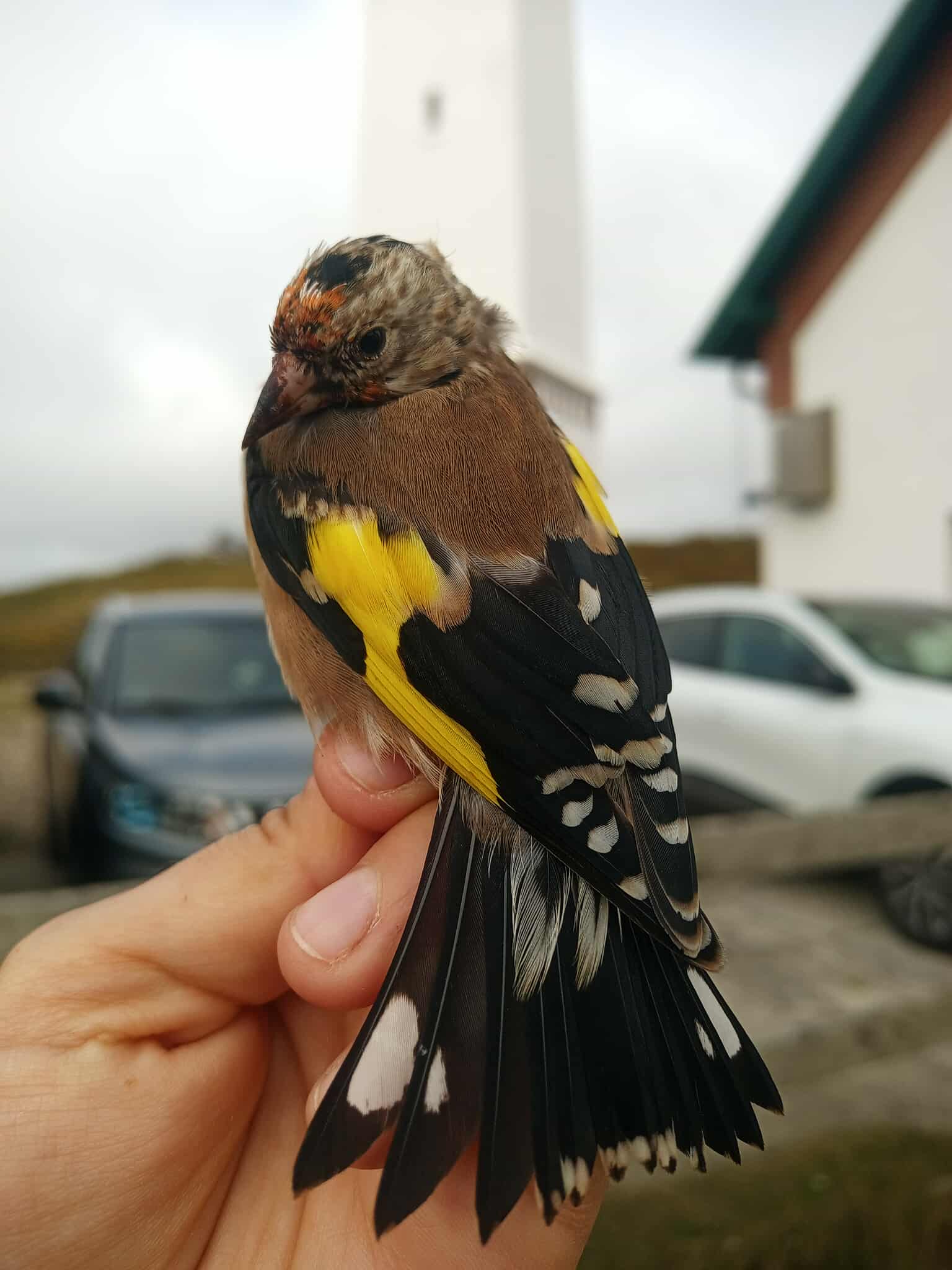Her på Blåvand's blog bringes korte nyheder i dagbogsformat om livet og hændelser på fuglestationen.
Se indlæg fra måned: feb. (2)mar. (31)apr. (30)maj (31)juni (10)juli (22)aug. (31)sept. (30)okt. (31)nov. (15)dec. (1)
Nerding sound and rare bills
Morgenobs:
The westerly wind continues. Henrik Læssøe, Mikkel Bello, Oliver Laursen and i sat sheltered and awaited the migrating birds of the day. Most birds, like the red throated divers, went north. We had a wonderful little auk (søkong) going south, Oliver saw it first and called it out. Later in the day we had two parrot crossbills (stor korsnæb) going north. We heard them, Mikkel caught them on audiotape, and i processed the sonogram. To register a semirare bird like the parrot crossbill you need a good dirscription typically paired with a soundrecording of the flight call for smaller birds. Today the sonogram looks like this.

- The sonogram shows five flightcalls from parrot crossbills
After the obs we tried to go find a rare pallas leaf warbler (fuglekongesanger). No luck but still a nice day. This is officiallt the last day of Felttræf, but people will probably stick around for a couple of days. So i am crossing my fingers for more rare birds througout the weekend. Tomorrow the wind will die down a lot and change direction:)
- SDP
Ringmærkning:
With the wind still being very strong, the day started off quite slow, with one goldcrest (fuglekong) and one robin. Later on we caught a small group of coal tits (sortmejse) and a few other new birds! With a bit more time on our hands, Anna and I (Lua) have been playing a lot "chunky birds", where we compare birds of the same species and the heaviest bird wins. Today it was my Robin (rødhals) on the right with 16.4 grams, against 15.8 grams of Anna's bird on the left!
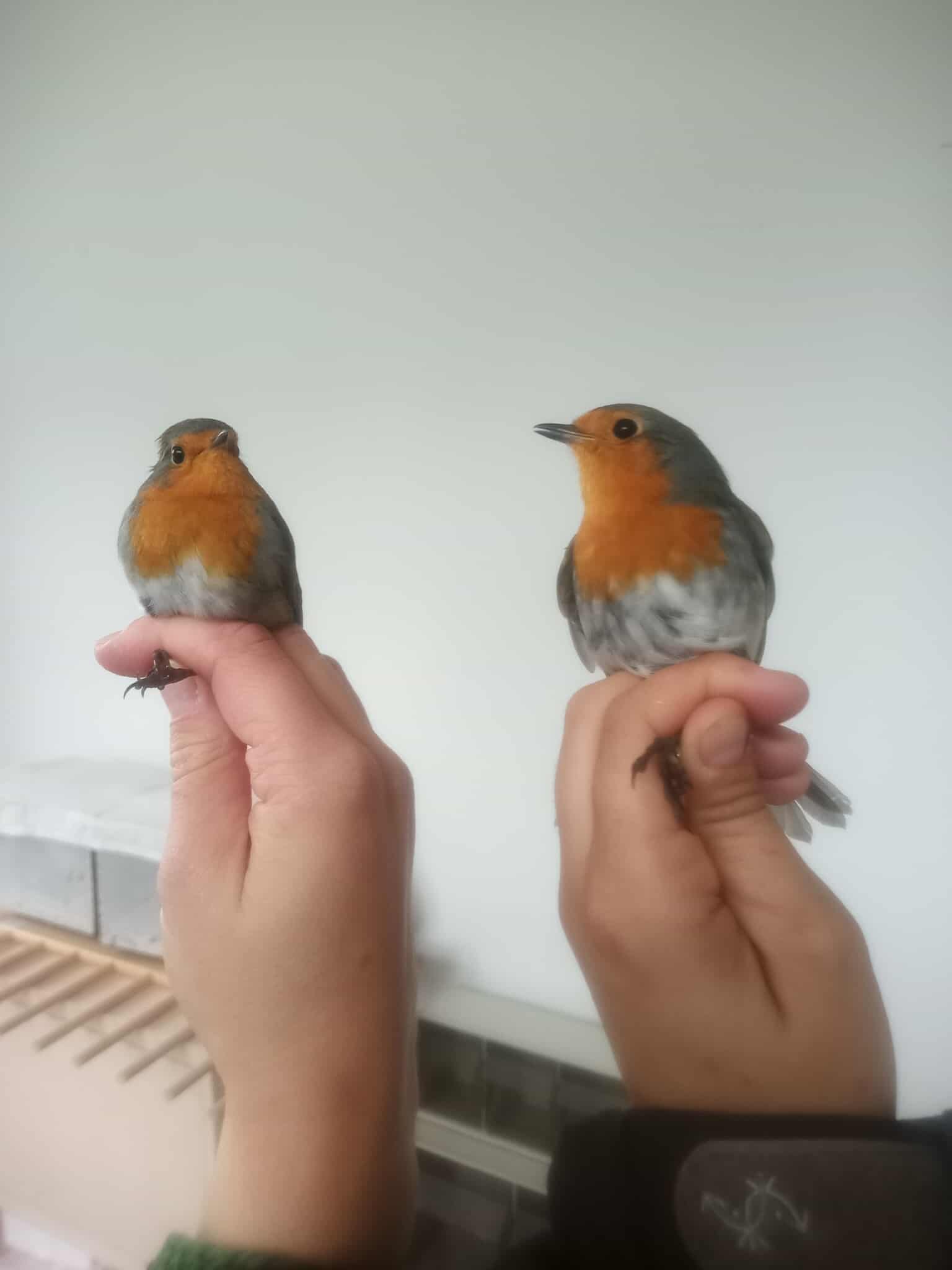
-LK
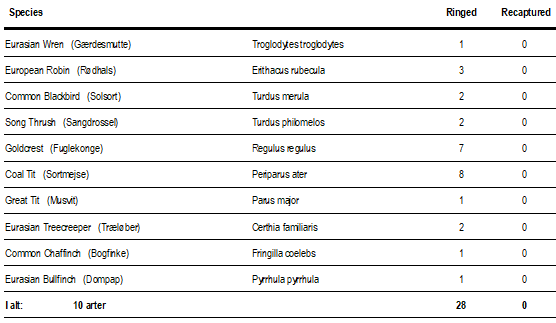
Folk på stationen: Lua Koplin, Sverre Dahl Porsgaard, Mathilde Lundt Larsen, Anna Beluga Gade-Jørgensen, Andreas Pedersen samt gæster i forbindelse med Felttræf
Alkefugle og nordvestenvind
Morgenobs:
Vi holder stilen (og vindretningen)! Det er stadig nordvestenvind, nu omkring 10-11 sekundmeter. De fugle som holder vindretningen ud er så småt ved at være trukket. Nu er der ikke så meget tilbage. Vi (Thomas og Jeg) havde en smule alkefugle, lidt lommer og en enkelt fløjlsand. Tja lidt suler og en dværgmåge gav os da også besøg. Småfuglene leverede heldigvis både lille korsnæb (32), stillits og bjerglærker (7). Henrik Böhmer sad på sydhukket, mens Thomas og jeg var på nordsiden. Omkring kl 09 kalder Böhmer ud på walkie-talkien appen zello. Han har en 3k hvidvinget måge, og den trækker nord! Et par sekunder efter fortæller han at den vendte om og fløj syd igen. Hverken thomas og jeg fik denne hvidvingede måge, som altså var et nyt individ, men flere DOF ung'ere fik den heldigvis.
Morgenobsen slutter og Thomas og jeg drager mod tipmosen, skallingen og lysbjerg hede for at lede efter fugle. Det blev til 8 sølvhejrer, en flok sortmejser, rørhøg, spurvehøg og lidt blandede ænder. En dejlig tur, efterfulgt af et smut forbi Strib sø. Imens vi er ude af huset finder Böhmer og David Manstrup en fyrremejse ved den nordlige branddam. De er ret sjældne herude, så endnu et lækker fund.
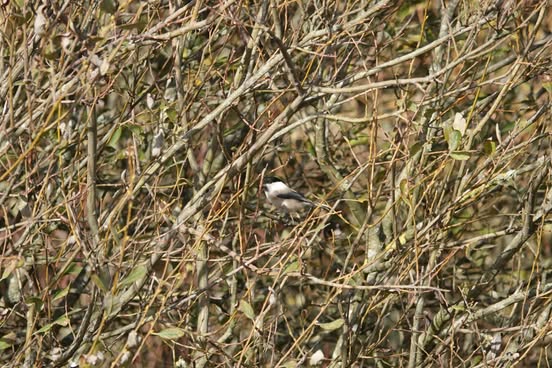
- Fyrremejse omkring den nordlige branddam, Foto: Henrik Böhmer
Om eftermiddagen bliver der fundet en søkonge nord for hukket i Børsmose af Mads Elley. Vi ved at det tager en fugl ca 20 minutter at flyve fra Børsmose til Blåvand. Så vi stiller os på ny ud i klitten og venter. Både Thomas og jeg ser den lille alkefugl flyve HURTIGT imod syd lige under revet. Aldrig har jeg set så lille en havfugl flyve så stærkt, det skyldes nok den stærke medvind. En dejlig fugl at slutte dagen af med. Dette konkluderer endnu en god dag i Blåvand:)
- SDP
Ringmærkning:
I dag har været endnu en stille dag pga vejret med kraftig vind af 10+ m/s. Derfor er det ikke meget at melde fra Ringmærkningsteamet. Trods vejret åbnede vi et par net for at sy de sidste huller. Den kraftige vind, gør det lettere at se huller i nettet. Og med lidt teknik kan man faktisk bruge vinden til ens fordel, når nål og sytråd skal føres igennem nettet
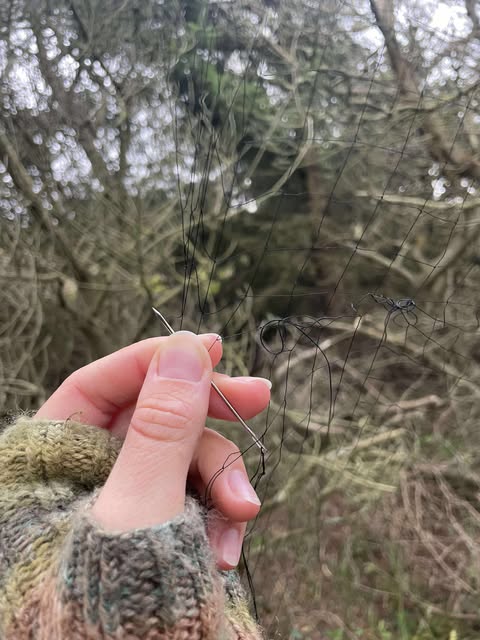
Et par fugle fandt vej til vores net, og pga. dagens rolige tempo, var der rigelig tid til at vise fuglene og ringmærkningsprocessen frem til besøgende familie. Det er altid sjovt at se gæsters begejstring, når havens fugle pludselig ses helt tæt på.
- AB
Folk på stationen: Lua Koplin, Sverre Dahl Porsgaard, Mathilde Lundt Larsen, Anna Beluga Gade-Jørgensen, Andreas Pedersen samt gæster i forbindelse med Felttræf
Netfixing and Chill
Morgenobs:
The wind is still going at it from northwest. With plenty of people to count the sea migration, we were hopeful to get everything cover. However we did not have a lot to cover. Some little gulls and a peregrine falcon (vandrefalk). Otherwise a calm and cozy morning at the obs. Nothing special, but not low enough numbers to bore us.
After the morning obs Thomas, Anders Myrthue and i went to service the helgoland trap. We patched some holes and improved the closing mechanism. After that we went kratlusking, and saw three stonechats (sortstrubet bynkefugl). The day ended with a nice lecture about wolves from Kent Olsen. Not a bad at all:)
- SDP
Ringing
With the wind starting to pick up a little, and the weather getting colder, we did not have that many birds, but the ones we did, where amazing as always! After getting a tiny flocks of the little stars of the bird world, the goldcrest (fuglekong). Things slowed down again as we were talking to some birdwatcher that then pointed out a greater spottet woodpecker (stor flagspætte) going directions our net. Just as we had forgotten that we saw the woodpecker and started heading down to check the net, we actually caught it!
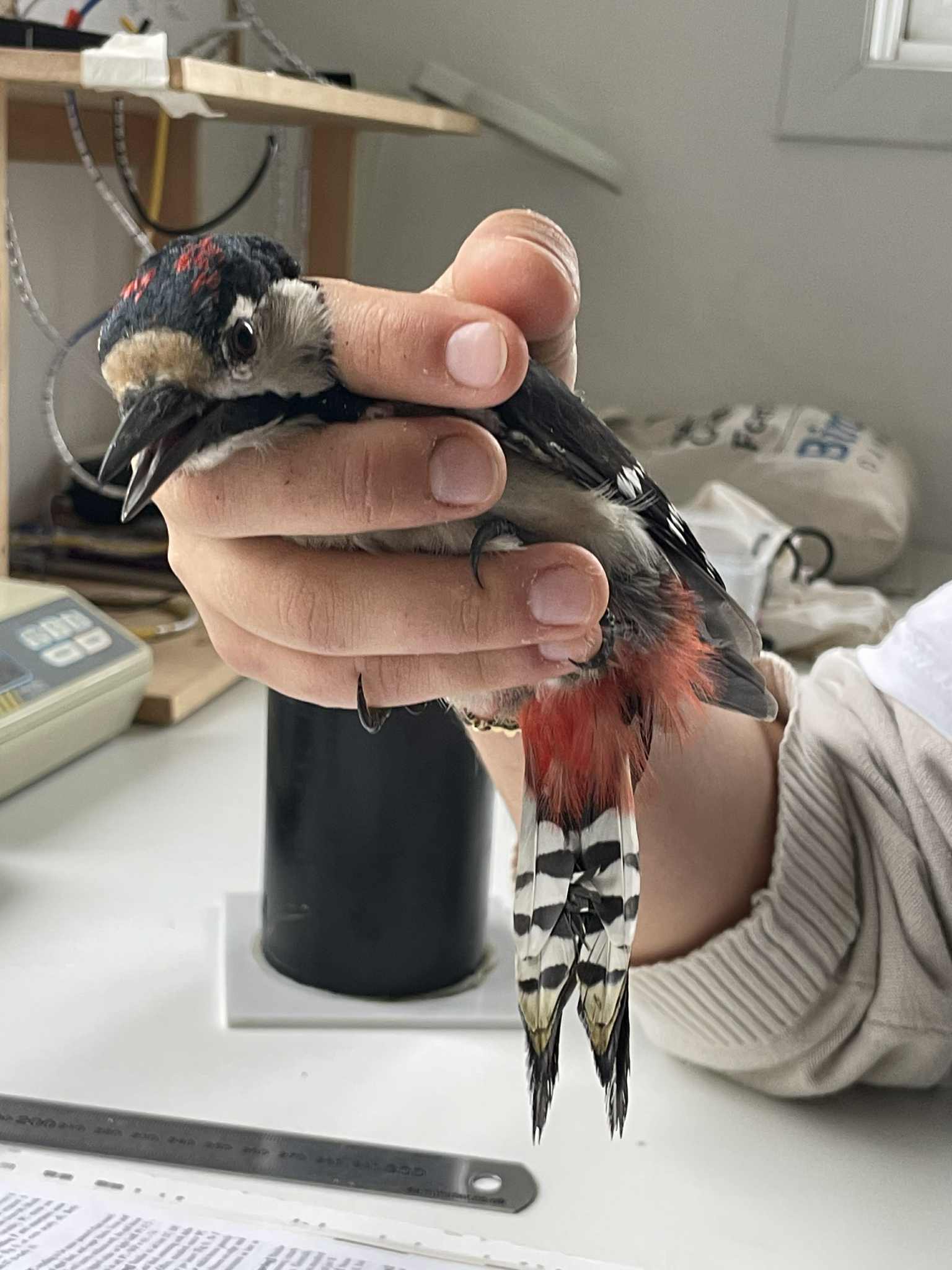
As this is a very beautiful and amazing bird to see in hand, we called it out for the young birders around to ask if they would like to see it.
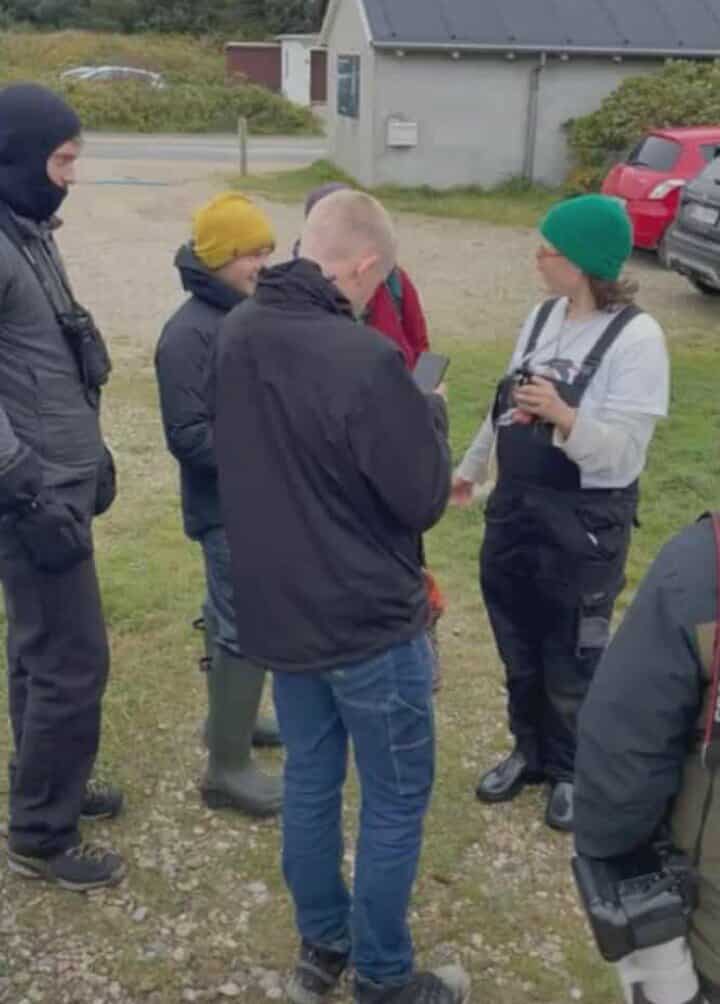
Which some of them did and we had a wounderfull little demonstration seasion, with plenty of questions ( from both sides) and alot of bright smiles after seeing this wounderful bird!
For the rest of the day, we used the extra time to fix some nets and the Helgoland Trap!
-LK
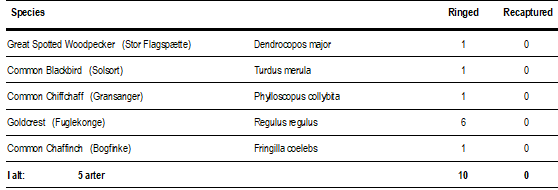
Folk på stationen: Lua Koplin, Sverre Dahl Porsgaard, Mathilde Lundt Larsen, Anna Beluga Gade-Jørgensen, Andreas Pedersen samt gæster i forbindelse med Felttræf
Mågeske er der sket noget spændende i dag!
Morgensobs
Så er der ved at komme fart over feltet! Vi stod i dag omkring 60 aktivt kiggende feltornitologer, fuglekiggere, ornitter, birders og hvad end man kalder dem. Største delen af det store antal bestod af DOF ung der nu har meldt sig til det store fugleslag i første klit række. De ihærdige (og enormt dygtige) unge birders, ankommer tidligt om morgenen på cykel med skop og kikkert svinget fabrilsk over nakken. Dagen i dag stod desværre stadig på nord-vesten vind, men selv det og en smule morgenregn kunne ikke stoppe den buldrende effekt af danmarks fuglefolk!
Igen i dag fokuserer vi primært på kvalitet frem for kvantitet. Af spændende arter og sjove besøg kan nævnes to vandrefalke, en dværgfalk, en blå kærhøg, omkring 30 rødstrubede lommer og en lapværling som Henrik Böhmer spottede på sydhakket.
Morgenens højdepunkt vistesig dog hverken at være småfugl eller rovfugl. Lidt i 10 spottede Henrik Læssøe en spændende måge på stranden. Den var lys, med lysegrå vinger, en grønlig næbbasis og ca. på størrelse med en sølvmåge. Efter en hurtig diskussion iblandt de absolut hårdeste og dygtigste feltbisser pejede enigheden imod en adult hvidvinget måge. Jeg tillod mig at tilsidesætte min tælling i et par minutter, for at foretage en spontan rastefugltælling fra stranden af hvor man også "tilfældigvis" kunne se og fotografere den lækre måge.
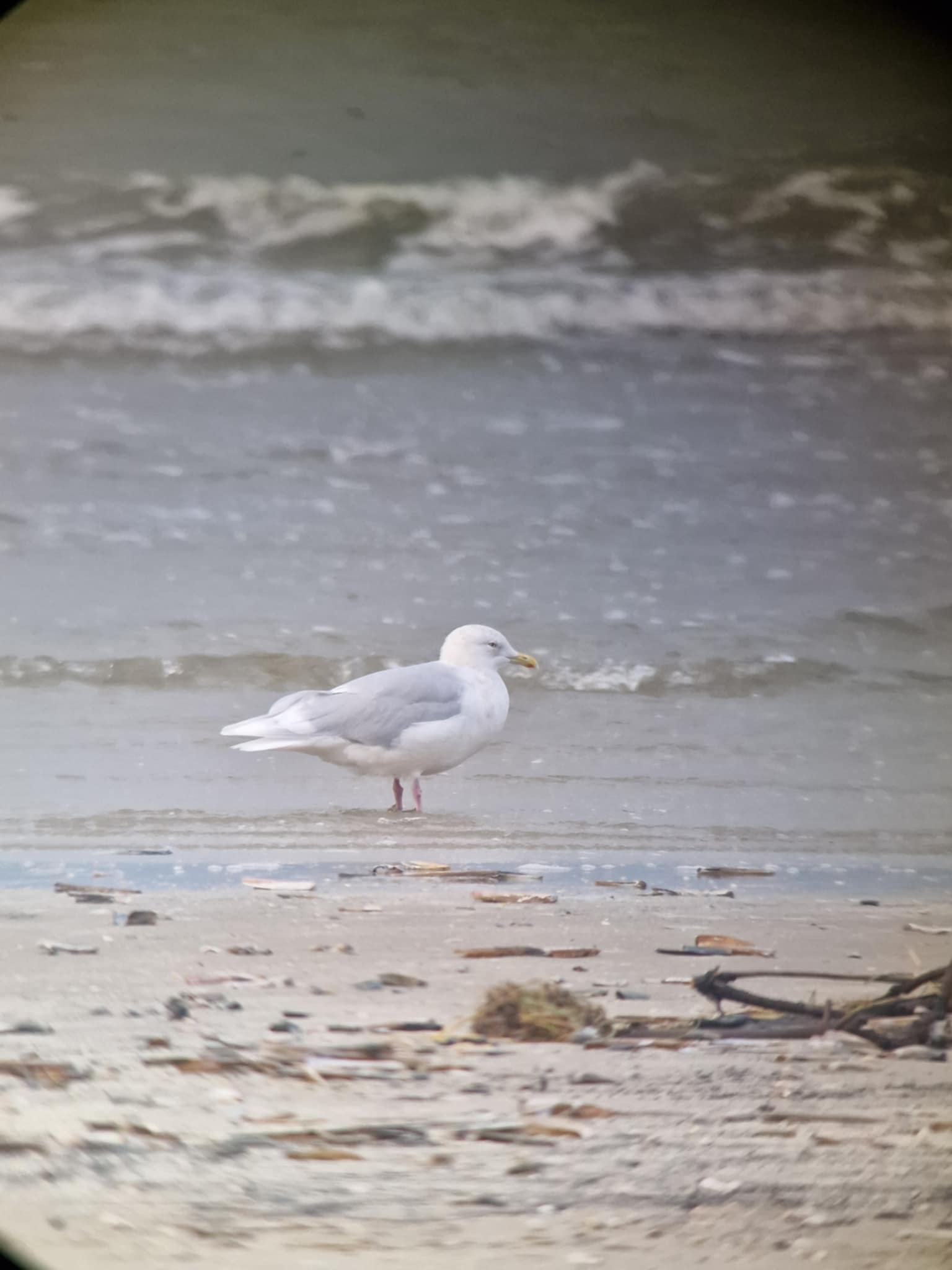
- Adult hvdivinget måge på nordhukket
Imens morgenobsen stod på havde Michael Mosebo fundet en SMUK adult brilleand han omkring sommerhus området på skallingen. Da det er en fugl jeg allerede har misset en gang i min tid i Blåvand, besluttede jeg mig for at den skulle jeg se. Så med et lift fra den altid flinke og hjælpsomme Jens Kirkebye befandt jeg mig lige pludselig på skallingen for dagens anden nye kryds for mit vedkommende. Super skønt! Jeg har desværre intet billede, da jeg selv har blot en gnidret sort glat i min linse. Så I må nøjes med mit ord, og holde mig til det:)
Der blev også fundet en fuglekongesanger omkring Ho plantage. Den fik jeg desværre ikke set, men mit håber et som altid stort og jeg forventer at genfinde den imorgen eller en af de kommende dage.
Om aftenen var der inviteret til foredrag med Hans Larsson på Blåvandgård. Larsson er en formidabel foredragsholder, illustreret til fuglebøger og sindssygt dygtig til måger. Han er dog også meget svensk og holdt derfor hele foredraget på sit modersmål med en tyk skånsk dialekt oveni... Ikke lige det nemmeste når der skal gennemgåes de mindste dragtdetaljer på über-sjældne rariteter, hvoraf flere ikke engang har gæstet Danmark. Måger såsom Tangmåge, Skiffermåge, Vegamåge, Japansk Måge Armensk måge og andouisin måge kan nævnes. Selv sjældne underarter såsom Inuitmåge blev gennemtrawlet. Inuit mågen er endda en underart af vores egne kære hvidvingede måge. Jeg kan godt sige jer at det var spændende, men også pænt hård kost klokken otte om aftenen. Ja der har været tryk på i dag, og med to nye arter er jeg godt tilfreds. Som sagt mange gange før, en god dag i Blåvand:)
- SDP
Ringmærkning
Vi skriver meget om mejser i bloggen i dette efterår- og i dag er ingen undtagelse. I godt 3 timer, var vi i fuld sving ved nettene. Musvitter, blåmejser, sortmejser - og også halemejser (selvom de jo ikke er egentlige mejser, som navnet ellers anstyder).
Parallelt med fallout i Fyrhaven, var Henrik i fuld sving i Stationshaven, med ringmærkningsturer. I dag har der nemlig været åbent hus på Fuglestationen. Og heldigvis var antallet af fugle mindre i Stationshaven, så der var tid til at vise de fine fugle frem under, og efter, ringmærkningen. Alt fra træløber, til halemejse og rødtoppet fuglekonge, blev vist frem til fuglekiggere i alle aldre. Især var det til stor begejstring at kunne vise halemejser frem, af både den sydlige og nordlige variant.
Til åbent hus kom både nye og velkendte ansigter. Snakken gik lystigt om fuglestationens arbejde, fuglene i området og historier om gode oplevelser fra foregående felttræf. Tak til alle der lagde vejen forbi- det er altid en stor fornøjelse at fortælle om vores arbejde til engagerede gæster.
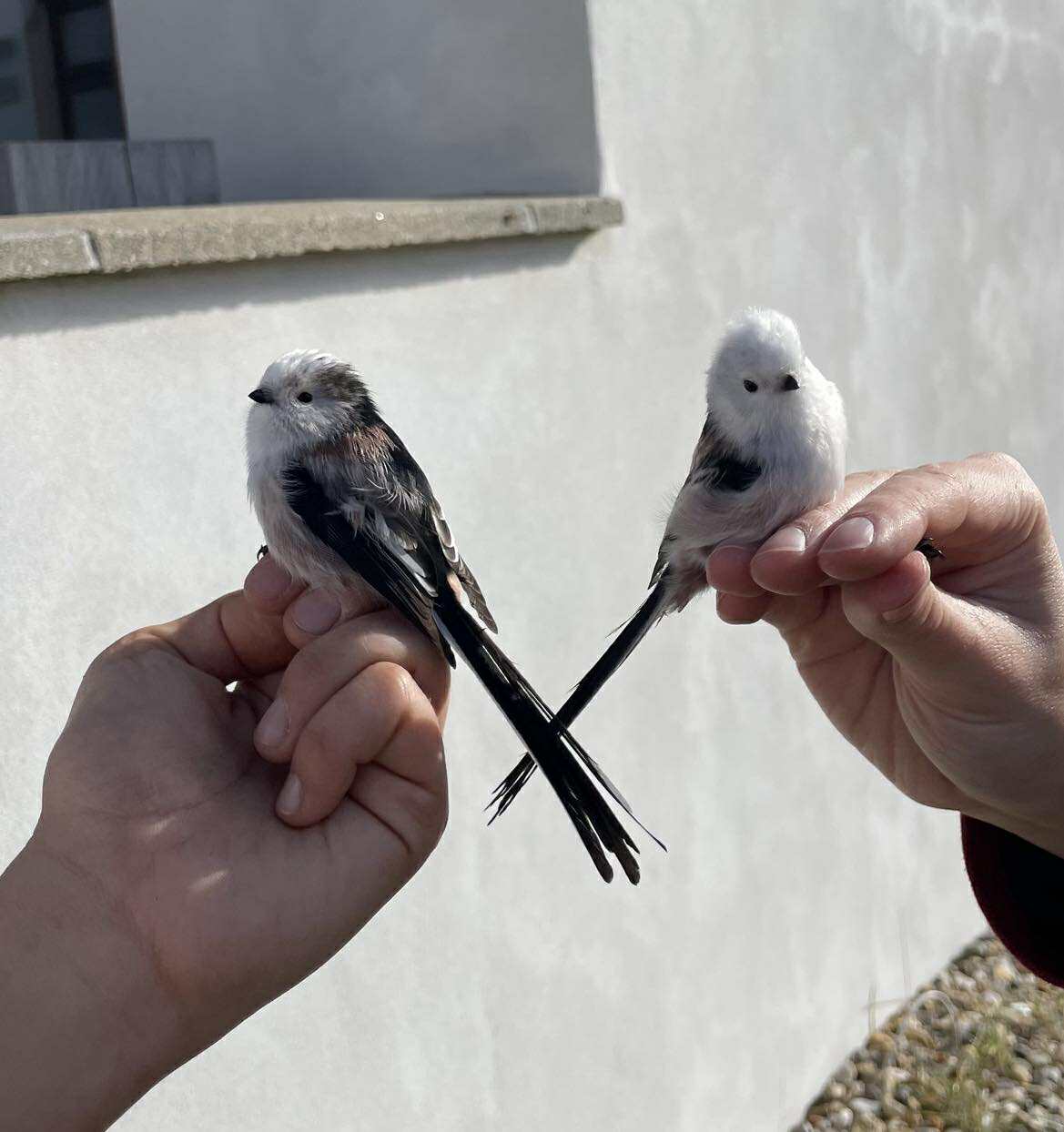
Halemejser i sydlig og nordlig variant.
-AB
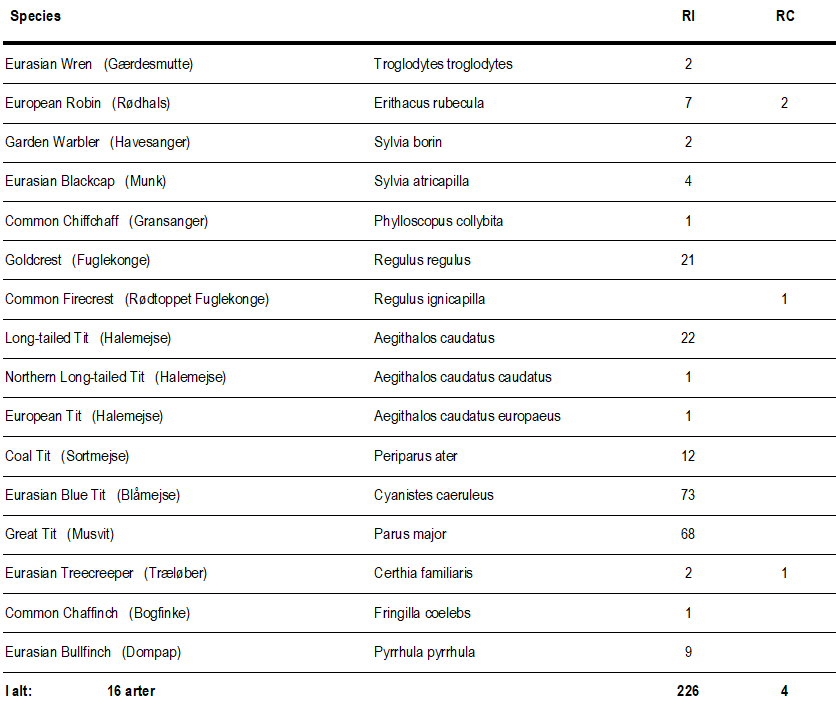
Folk på stationen: Lua Koplin, Sverre Dahl Porsgaard, Mathilde Lundt Larsen, Anna Beluga Gade-Jørgensen, Andreas Pedersen samt gæster i forbindelse med Felttræf
Low winds and special birds in and above the net
Morgenobs
The wind died down! We are now down to a mere one meter per second from southeast! Thats exciting as it brings new birds to the area. The day started off great with a BEAUTIFUL peregrine falcon (vandrefalk) eating a meal mid air! What a sight, suvh a graceful animal devouring another bird without even landing.. Next up we had some golden eyes and mallards (hvinand og gråand) along with teals, pintails and wigeon (krikand, spidsand, pibeand) and almost 200 eiders (ederfugle)! Not a bird day for the diversity of the duck species. I heard on the grapewine (the walkie-talkie app zello) that Henrik Bøhmer and the ringers saw a KINGFISHER over the lighthouse garden. That is incredibly rare out here and only the fifth find for the area, the fourth being earlier in the season. The most exciting bird of the day was a beautiful great northern diver (islom) flying north over us. It looked enormous with its clumsy feet sticking out from behind, definetely a first for me. What a day at the obs. Nice with a busy day before its back to the north western wind tomorrow.
After the obs, Henrik, Thomas and i went further down the beach to look for rare scoters like surf scoter or american scoter. We did'nt find anything worth mentioning, but fun none the less.
Later in the day the youth part of DOF arrived to the area. I was on a wonderful camp in the spring, with these young an talented birders. I met a lot of cool, experienced and kind birders and i look forward to seing them again in the coming week. You can easily spot the young birders in Blåvand, as they tend to bike around at full speed with a scope flinged around their back;)
- SDP
Ringmærkning
Today was a very exiting day! It started a few thrushes, including 2 beautiful red wings (vindrossel)! Then after getting a few flocks of goldcrests (fuglekonge) we had our first fire crest (rødtoppet fuglekonge) of the morning, which we were able to show to a nice sized group of enthusiastic birdwatchers! After a lot of busy rounds we ended up getting 3 greater spotted woodpeckers (stor flagspætte) and then our second fire crest! As the day dragged on, as a last bird of the day we had my(Lua) first Red Crossbill! A wonderful young female! And after a busy day of ringing, we ended with over 200 birds! What a great Autumn day!

- a Female red crossbill (lille korsnæb)
- LK

Folk på stationen: Lua Koplin, Sverre Dahl Porsgaard, Mathilde Lundt Larsen, Anna Beluga Gade-Jørgensen, Andreas Pedersen samt gæster i forbindelse med Felttræf
Birders på 'hukket' og Guld i nettet
I caspianot believe this day
Morning Observation
The wind is still the same... Nothing much is happening over the sea except for some razorbills and guillemots, and a sigle velvet scooter. Most birds go north in days like this. A bird of meadowbirds, some nice big flocks of red crossbills, a teeny bit of chaffinches and les than five bramblings. Not a lot of birds wanted to fly today, so we enjoyed a good look at all the resting birds. I counted eight red throated divers (rødstrubet lom), approximately twenty greater black backed gulls (svartbag) and even a BEAUTIFUL 1k caspian gull (kaspisk måge). The lead for best birds today is either the caspian gull or the four merlins (dværgfalk) we had today. The caspian gull can be hard to destinguish from the hering gull. But there is a lot of small differences like the cvaspian being a bit thinner with a more flat fronthead and bigger contrast in colors. In their winter plumage they are easier to tell apart as the herring gulls head becomes more gray, whereas the caspian gulls stay white in all plumages:)
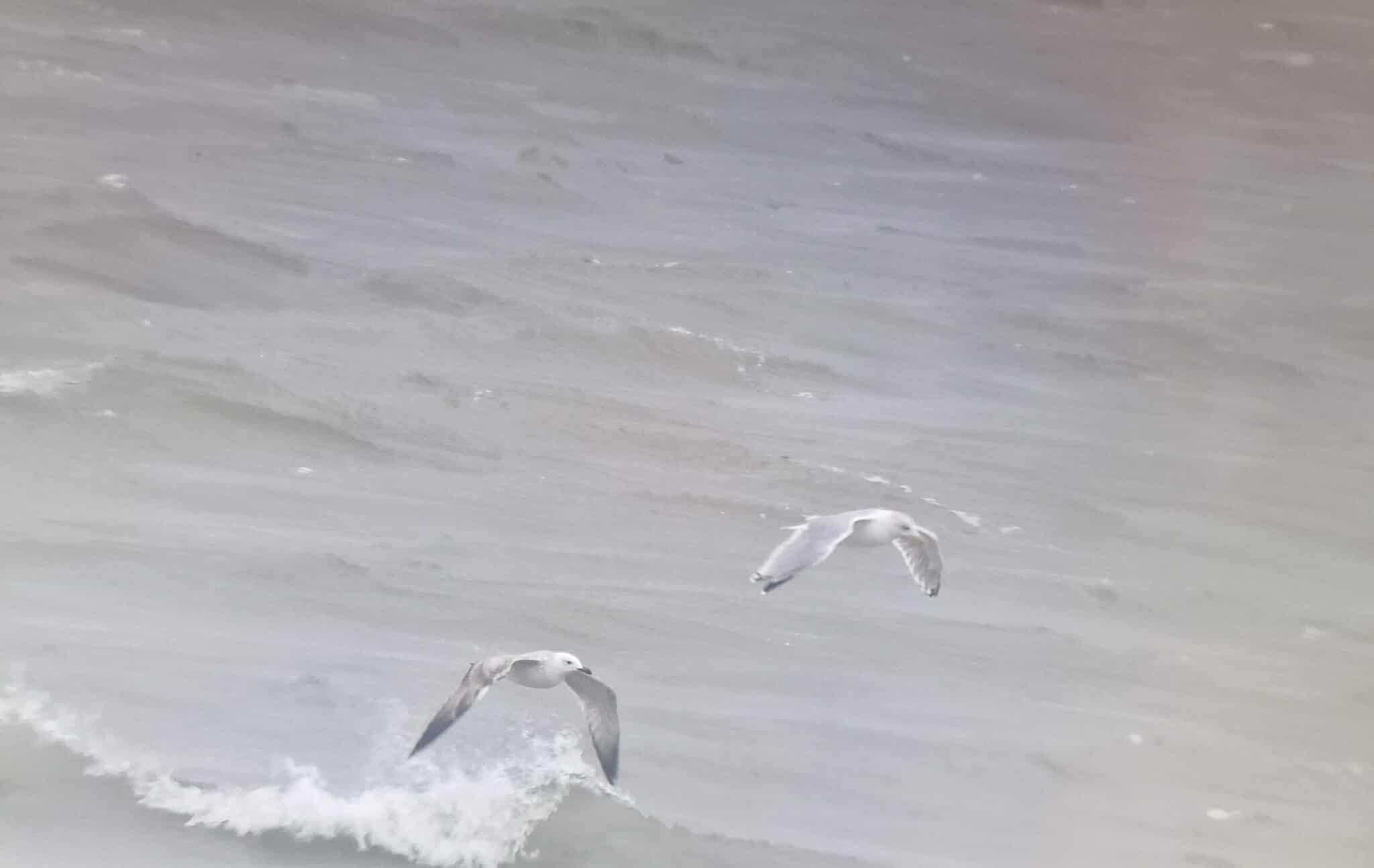
- 1k Caspian gull (left) and adult herring gull (sølvmåge, right)
After the morningobs we (Andreas Pedersen, Mikkel Bello and I) went looking for rare birds. Not a lot of activity in the shrubberies, but definetely a nice walk and day none the less:)
- SDP
Ringing
As the wind was a bit to strong to open the nets straight away, we used this opportunity to do a maintenance day! Great fun! Mathilde and myself (Lua) fixed a few wind damaged nets, did some leaf control and cut some wood around the nets.

Henrik was in the same headspace and cut the lawn around the nets at the station, everything is nice and in tip top shape! Later on it was possible to open some of our nets, as we had seen a nice movement of diffrent tit flocks. We mainly caught coal tits (sortmejse) but also had a nice little selection of blue tits, great tits, blackcaps and two beautiful bullfinches in their very fresh and shiny adult coat!
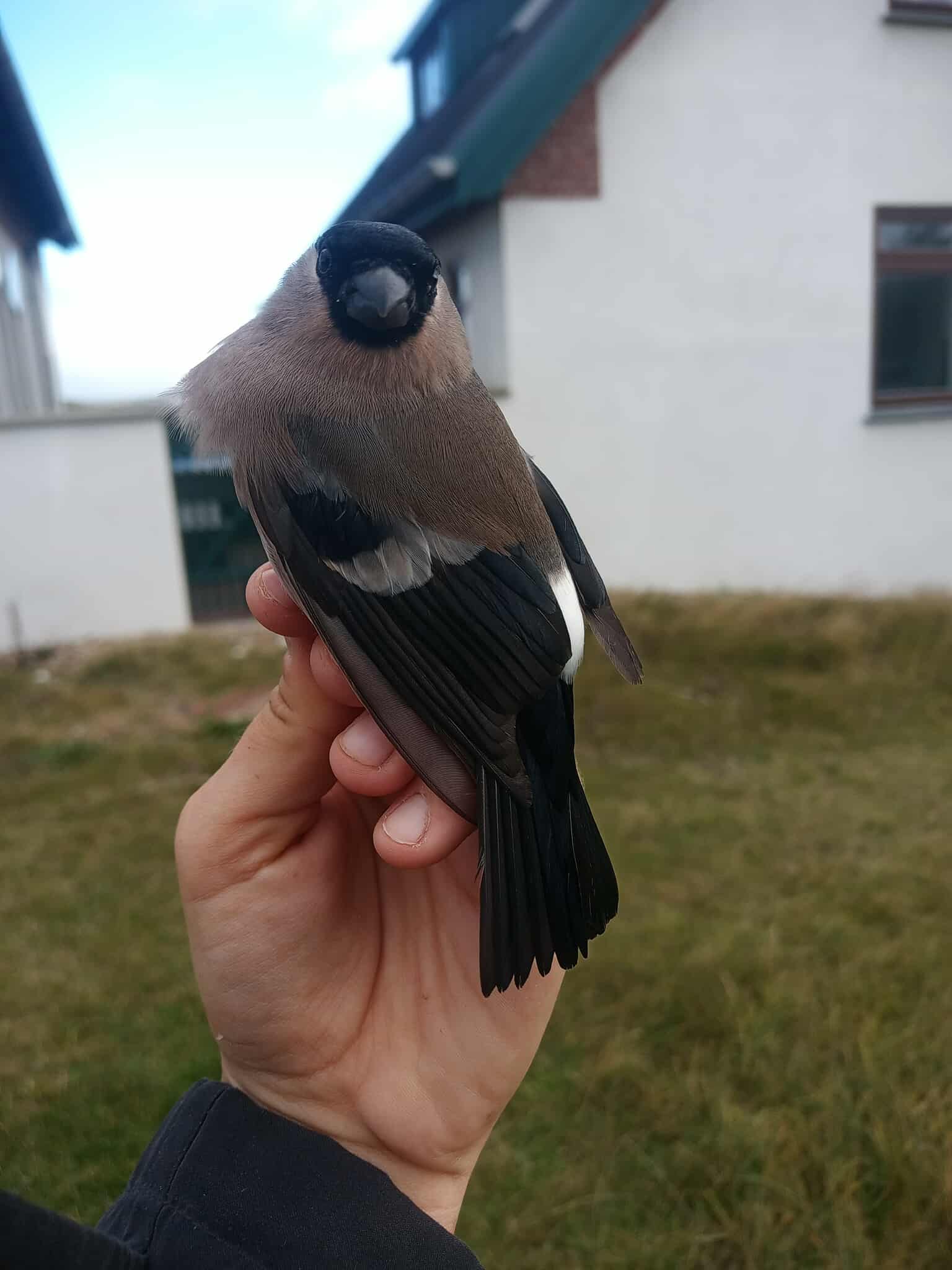
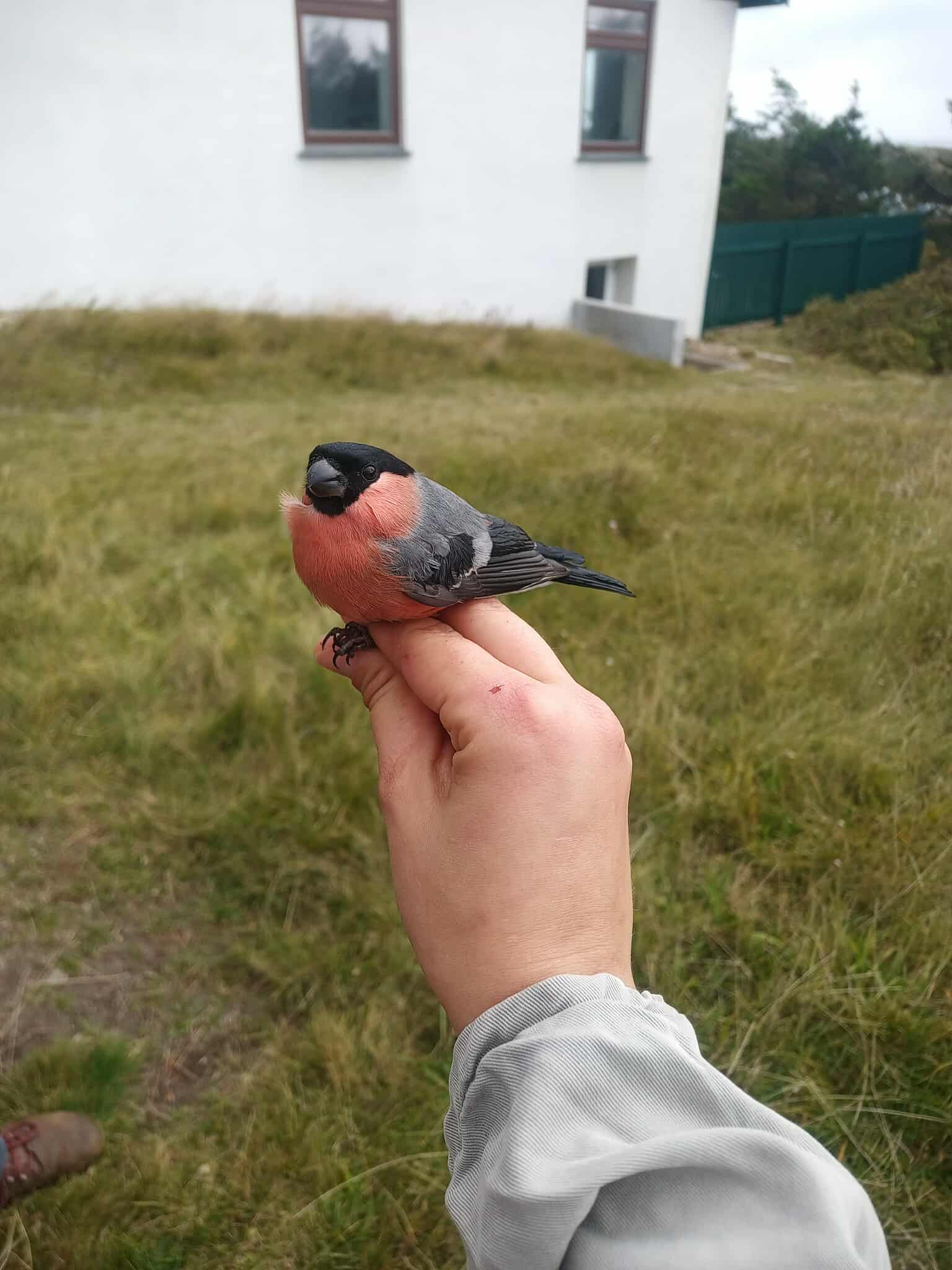
-LK
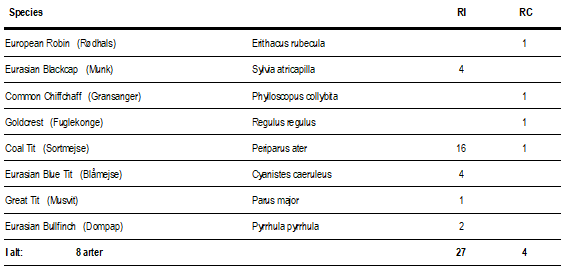
Folk på stationen: Lua Koplin, Sverre Dahl Porsgaard, Mathilde Lundt Larsen, Anna Beluga Gade-Jørgensen og Andreas Pedersen
Forberedelser og lusketure
Morgenobs
Igen i dag, vågnede vi op til den hårde nordvesten vind, det gjorde at vores håb om en fuglerig morgenobs var små. Det viste sig desværre at holde stik, da der kun var enkelte dværgmåger og rider, der trak langt ude bag revet i mellem skumsprøjt og bølger. Men når kvantiteten glipper, må kvaliteten tage over. Klokken lidt over 9 melder böhmer fra sydhukket at der er en tikværling der lige har fløjet over ham mod nord. Vi ved derfor at det enten er en dværgværling eller det der er sjældnere og den er på vej mod os på nordhukket! Sverre, Mikkel Bello og jeg venter i spænding og til hører vi det lille tik og vi er alle glade og meget tilfredse med obsens udbytte. Senere op af dagen tager Mikkel nede i mosen og finder et hvidbryn. Jeg ønsker at se den og går derned, i forhåbning om at der er flere. Vi bliver ikke skuffet for udover den, ser vi 2 ved makisanger krattet sammen med 17 agerhøns.
Resten af dagen gik med kratlusk i tipmosen, der gav 3 rødtoppet fuglekongen, 2 fyrremejser, en enkeltbekkasin og endnu et hvidbryn. Det er gode dage i Blåvand.
- AKP
Ringmærkning
Morgenen startede ud mørk og forblæst, så ringmærkningen blev udsat. Mens vi ventede, på at vinden ville lægge sig, deltog jeg i morgenobsen og derefter ude og sondere terrænet ved branddammen.
Vi åbnede nettene midt på dagen, men det førte ikke til mange fugle. I første runde fik vi syv fugle på tværs af et par af de almindelige arter, derefter i de senere runder mest genfangster. Det gav dog også en genfangst af en solsort, som ikke var i vores systemer, og sandsynligvis kunne være fra Skagen, da den er ringmærket i Danmark og er fra i år (1k).
Vi satte også to nye net op, der skulle udskiftes, så vi er helt klar på de alle de fugle, vi forhåbenligt vil få i nettene i den kommende tid.
Resten af dagen blev brugt på at gøre klar til felttræffet i den kommende uge, hvilket blev indledt med, at der blev fundet to hvidbrynede løvsangere i området. Den ene ringmærket, måske nok en af dem, vi har ringmærket her på stationen. Med felttræffets indtræf i Blåvand, ankom også flere gæster til stationen, som vil være her i den kommende uge. Jeg er personligt også spændt på DOF UNGs efterårslejr i Blåvand i den kommende uge, hvor over 40 unge fuglekiggere vil gå i felten og forhåbentlig finde mange gode fugle.
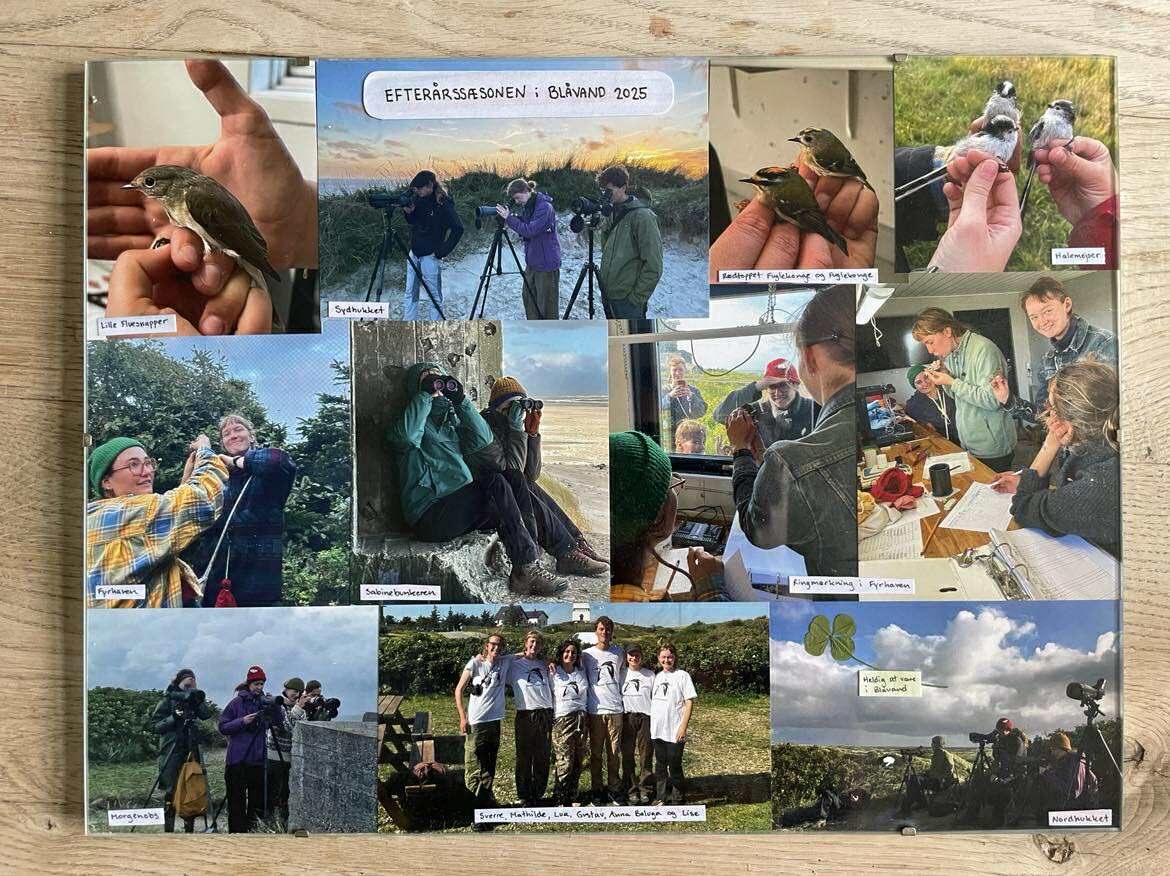
Kollage af indtryk fra efterårssæsonen.
Når vejret ikke er til ringmærkning har vi nogle krea-projekter kørende også. Anna Beluga har lavet den overstående kollage af de frivillige på stationen dette efterår og vores aktiviteter. Det kan blive en god måde at huske minderne på.
- MLL
Folk på stationen: Lua Koplin, Sverre Dahl Porsgaard, Mathilde Lundt Larsen, Anna Beluga Gade-Jørgensen og Andreas Pedersen
Chunky Finches ( Fede Finker )
Morning Observations
With mediocre winds from westnorthwest we set out for another day at the obs-point. We were joined by Anders, Jan, Bent and Henrik for the forst two hours of the day. We quickly realised that the main migration of the fay did in fact not pass over the water but by land. The day brought a lot og chaffinches and bramblings (bog- og kvækerfinker), some occasional meadow pipits (engpibere) and other small finches flying overhead. But primarily finches... like a lot of finches. 2000+ passing by the observation post. Of course we also had some scoters (sortænder), red throated divers (rødstrubet lom) and one velvet scoter (fløjlsand). A couple of sparrowhawks passed by, and Henrik saw a possible Pallid Harrier that was too far away for us to fully identify. Otherwise the day was a bit quiet. Especially the last half an hour with light rain. For this period of time it was just Andreas and i left to count the "multitude" of birds in the last half an hour. An occasional fun day at the obs with the great numbers, and as always a great day here in Blåvand:) - SDP
Ringing
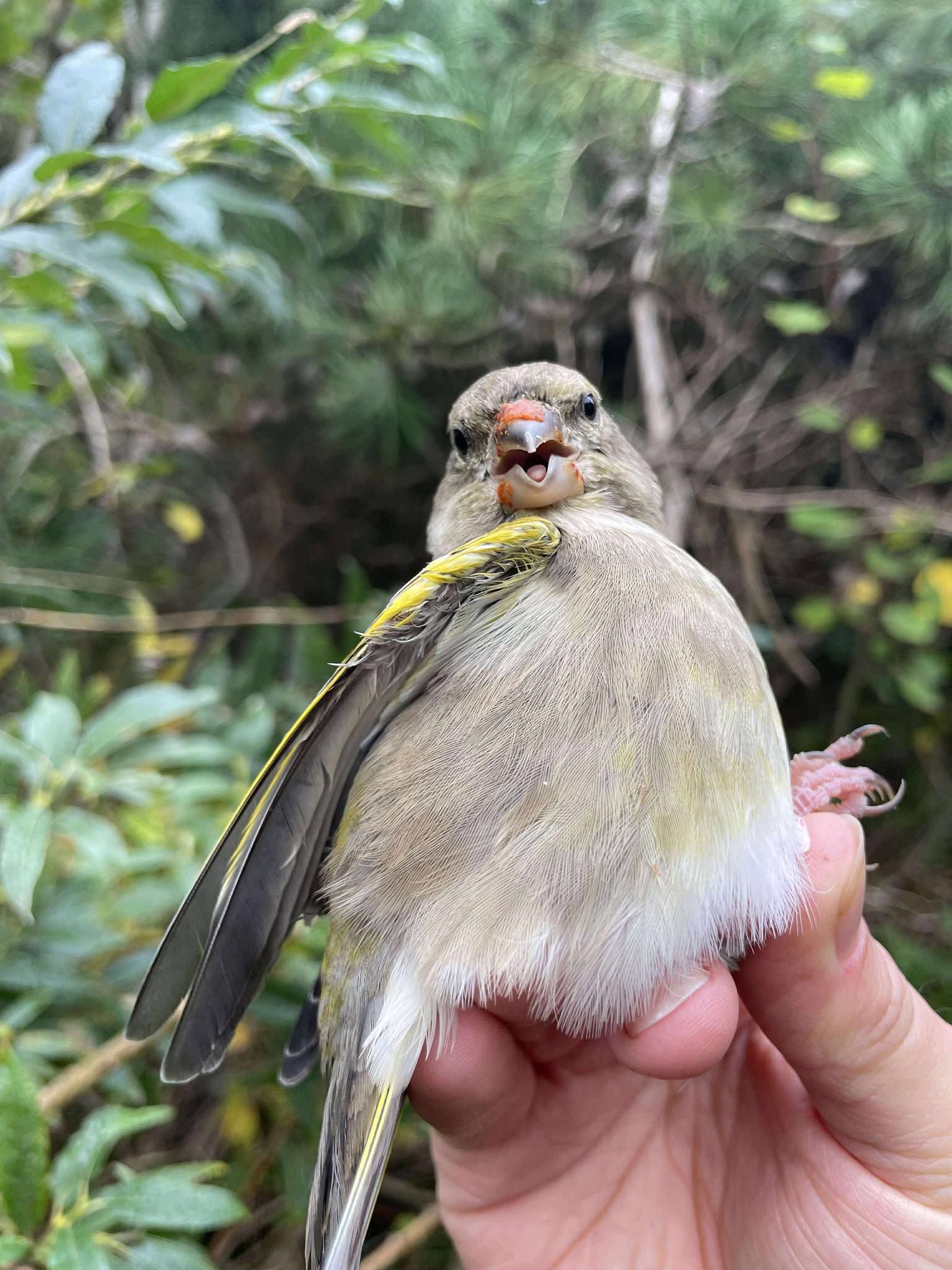
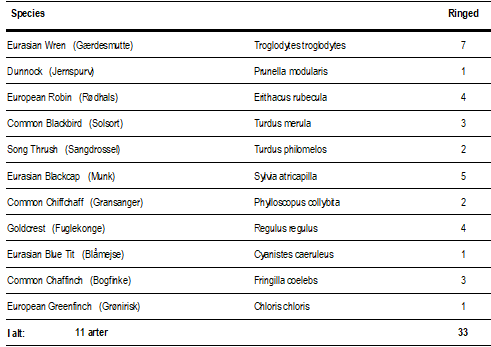
En fugle-formidable dag i Blåvand - a real tern of events
Morgenobs
Endnu engang viste Blåvand sig fra den gode side. Vejret var varmt, og vinden var væk fra det berygtet dræberhjørne nordvest. Vi startede stille og rolig med lidt havtræk af rødstrubet lommer og de altid tilstedendeværende sortænder, men op ad dagen steg intensiteten af småfugletrækket så vi havde lidt at tælle. Det var dog ikke inden over land at dagens første hit kom. Klokken lidt i 9, ser vi en gigantisk terne bag revet. Min første tanke er at jeg må spist eller drukket noget der har sat mine sanser ud af spil, da det utvivlsomt ligner en Rovterne! Sidst jeg tjekkede kalenderen var vi i oktober, men da jeg ser det sorte felt yderst hånden og det koral røde næb, får jeg fremtvunget de svære ord selvom jeg næsten får et surt opstød af at komme med sådan en mærkelig melding. Ovenpå den surrealistisk oplevelse fortsætter obsen stadigvæk med en del træk. Spurvehøgene gør sit indtog, og flere blå kærhøge patruljerer nede i mosen. På et tidspunkt siger Sverre, at der kommer vist et par kærhøge over hovedet på os. Jeg når at sige, inden jeg får kikkerten på dem, at det nok er de samme blå kærhøge der har været nede i mosen, men der tager jeg grueligt fejl! En af dem er godt orange, og hånden er smal. Den har potentiale til at være sjov! Febrilsk prøver jeg at fange den i skop, hvilket jeg ved at lykketræf gør og BANG, der er jackpot: Stor fed halskrave, efterårets tredje steppehøg er en realitet. Alle er glade og vi lukker den daglige træktælling med manér.
Ovenpå den vilde morgenobs vender Sverre og jeg hjemad. Jeg vil i mosen og Sverre tager til Jersild med Sven Bødker. Vi fik begge the blues, men jeg vil sige Sverre fik det på den gode måde. Han så de Blå glenter både parre sig, æde og blive jaget af krager. I sådan et øjeblik kan man virkelig se hvor lille den er sammenlignet med de andre glenter, fortalte Sverre! Det må være et lækkert syn at få dem så tæt på, og et dejligt minde om deres blå glente fra start august.
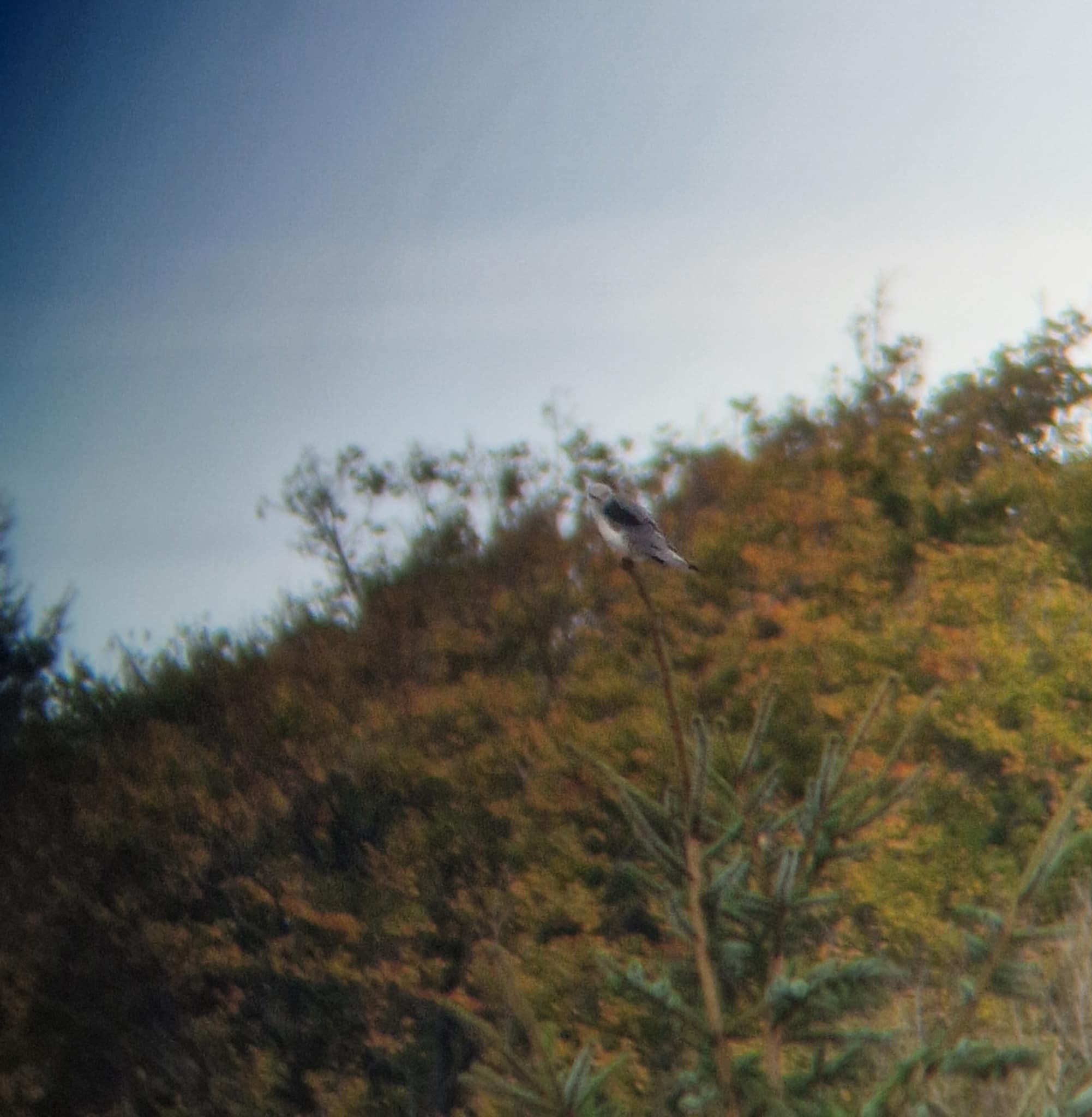
- En af de to blå glenter fra Jersild
- APR
Ringmærkning
Idag har været en dag med gang i den!
Mange fugle og specielle fugle. Velkendte fugle og nye fugle for sæsonen. Høj sol og silende regn. Sæsonens første Vindrossel blev en af dagens første fugle. Sammen med Sangdrossel, bød den dagen velkommen. Vi nød den smukke fugl og studerede fuglens røde fjer og lyse øjenstribe. Især bemærkede vi størrelsesforskellen mellem Vindrossel og Sangdrossel. (Her beklager vi manglende foto, da en pludselig regnbyge, stjal vores opmærksomhed).
Regnen var hurtigt overstået og dagens første solstråler skinnede i vanddråberne. Og med ankomsten af solen, kom mejserne. 132 mejser landede på skift, og holdt os travle i lang tid. Langt størstedelen var Blåmejser, en stor del var Musvitter og et par Sortmejser sneg sig også med. Da vi havde tørret sveden af panden efter mejse-fallout, fandt vi de jakker vi havde smidt undervejs og begav os tilbage mod Stationshaven. Her ventede os en lille fin overraskelse. I samme net og næsten på præcis samme placering i nettet, fandt vi sæsonens 2. Hvidbrynet Løvsanger. Med begejstrede tilskuer, blev der taget billeder og fortalt historier foran Fyrtårnet i oktobersolen.
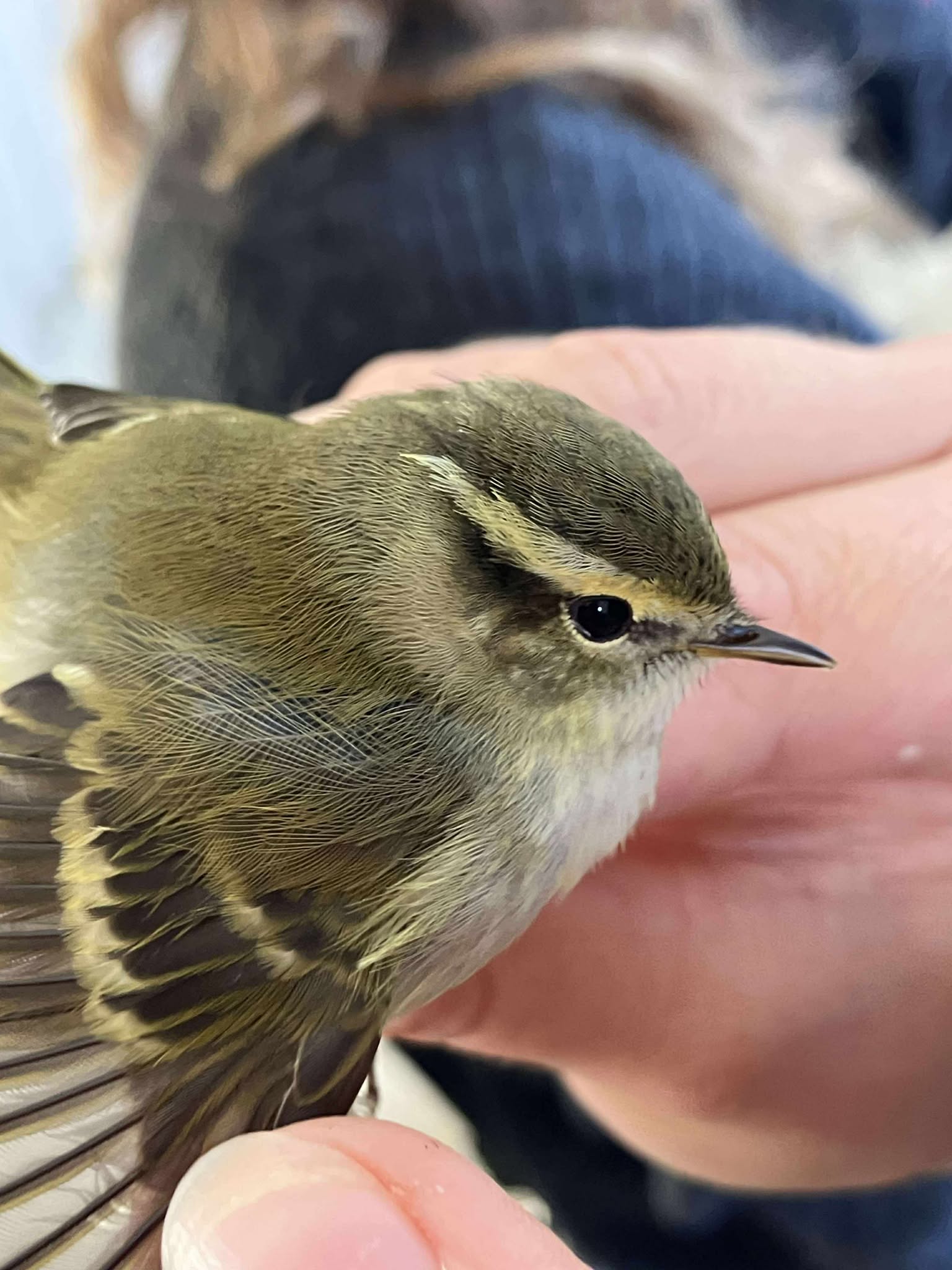
Hvidbrynet Løvsanger under ringmærkning.
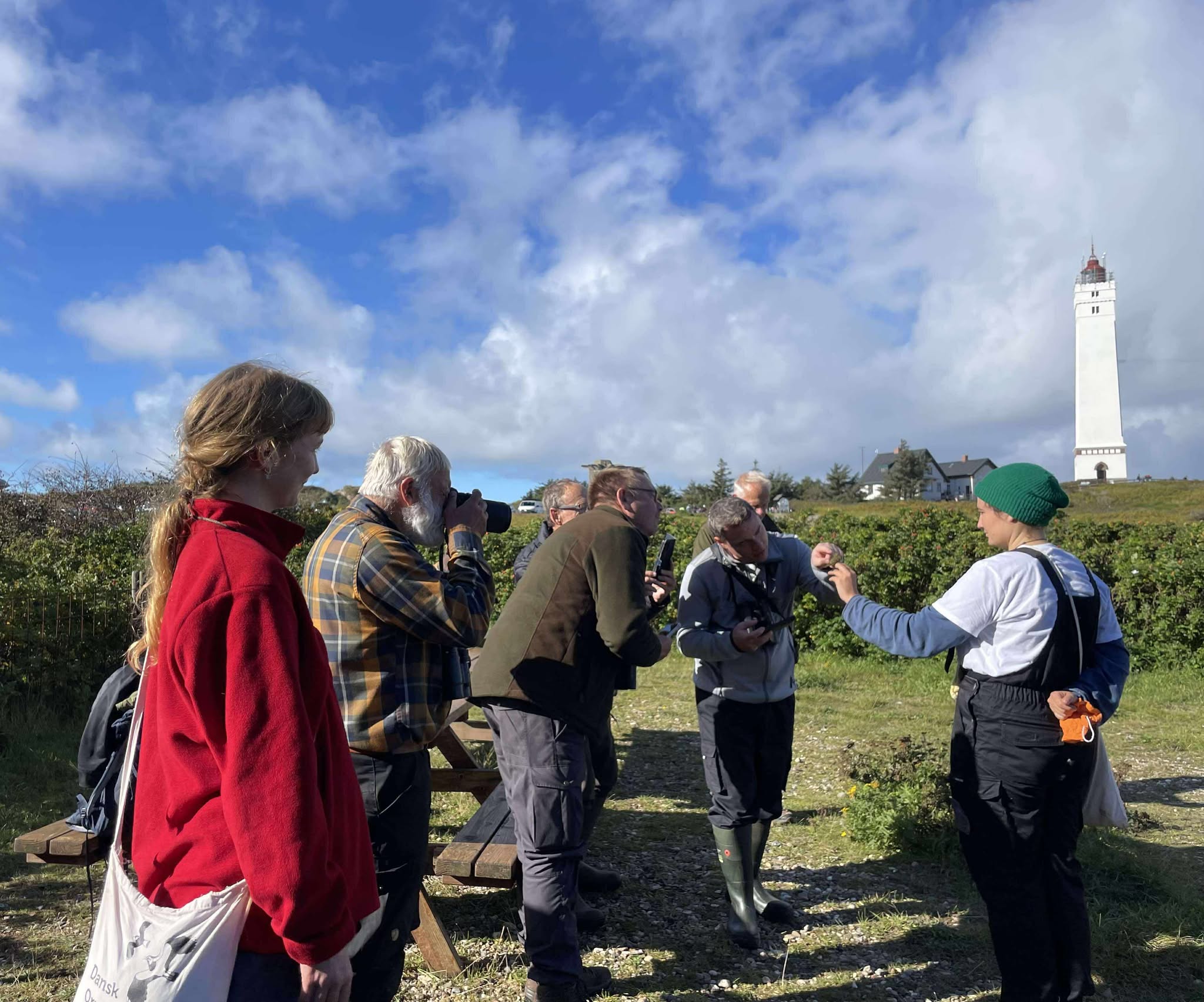
Fremvisning af Hvidbrynet Løvsanger.
Også GrønIrisk, Halemejser, Solsort og Skovspurv fandt vej til nettet, blandt vores mere daglige gæster af Fuglekonge, Munk, Rødhals, Sangdrossel, Gædesmutte, Jernspurv, Bogfinke, Blåmejse, Musvit og Sortmejse. Vi havde bl.a. en genfangst af en Bogfinke, som var ringmærket her i Blåvand d. 29. september 2024. Det er en varmende tanke at den har overlevet sit lange træk og lagt vejen forbi Blåvand igen. Men ikke en eneste Gransanger blev det til i dag.
Nogle af dagens sidste fugle, blev en flok på 7 Halemejser. En lille “sweet treat”, efter en lang travl dag. Da vi havde bedre tid her sidst på eftermiddagen, fremviste vi Halemejserne frem til en flok turister, som begejstret lyttede med på Lua’s formidling og så til med store øjne, da vi slap fuglene fri i flok. Vi gik glade og tilfredse hjem, efter ringmærkningen af 216 nye fugle.
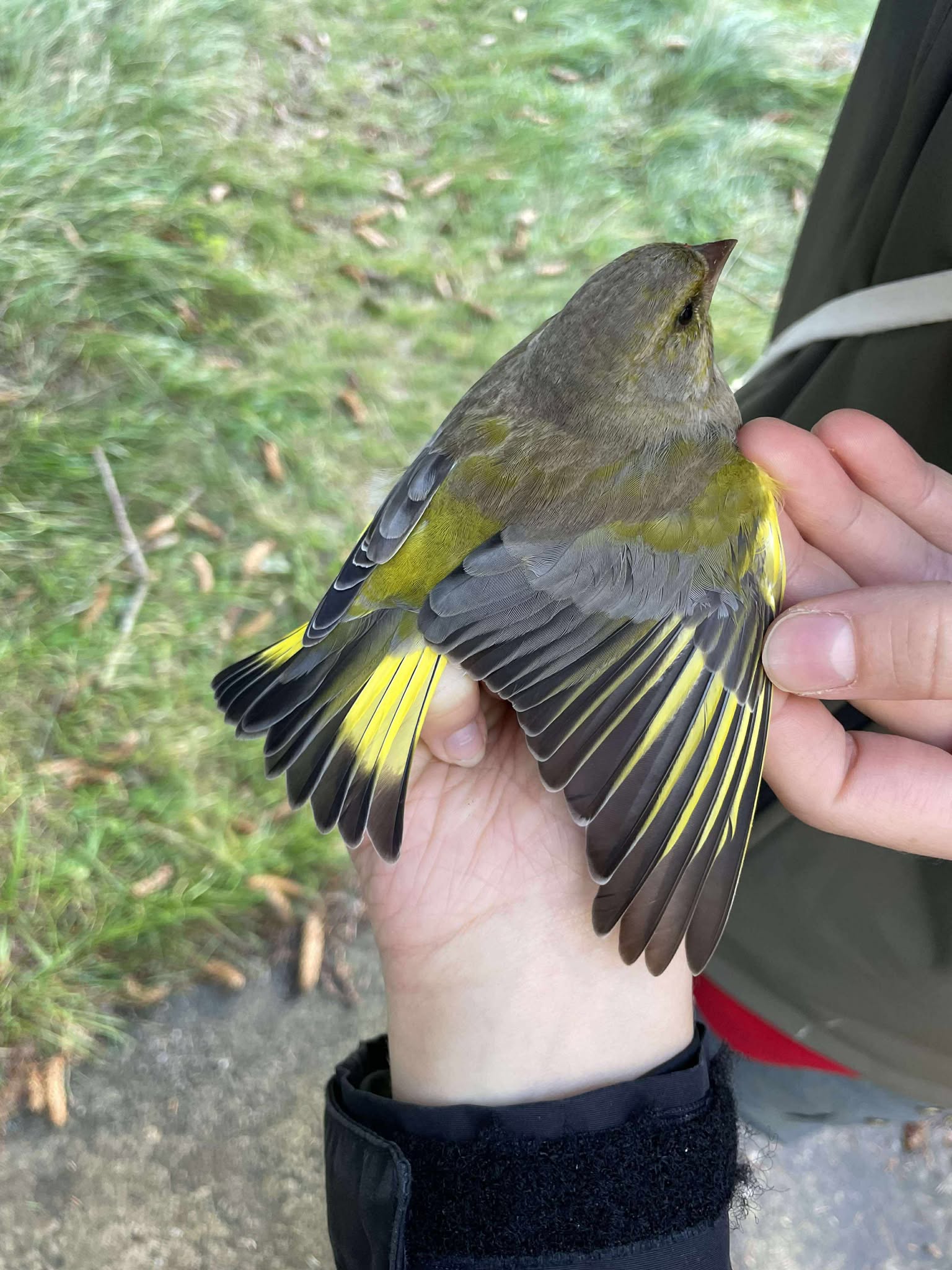
Grønirisk i Stationshaven.
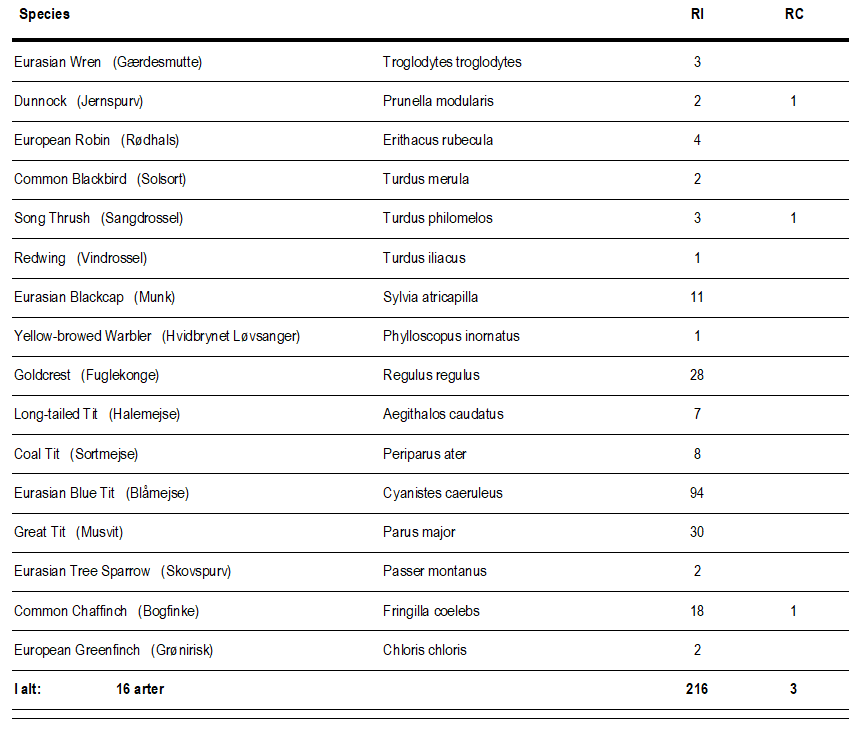
- AB
Folk på stationen: Lua Koplin, Sverre Dahl Porsgaard, Mathilde Lundt Larsen, Anna Beluga Gade-Jørgensen og Andreas Pedersen



